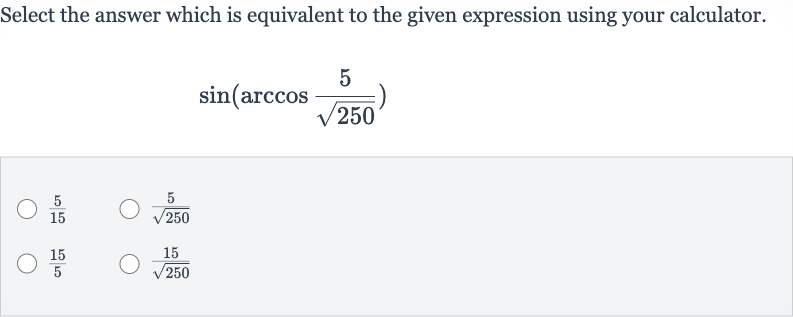Full solution
Q. Select the answer which is equivalent to the given expression using your calculator.
- Understand Relationship Sine Cosine: Understand the relationship between sine and cosine in a right triangle.The sine of an angle is equal to the opposite side over the hypotenuse, and the cosine of an angle is equal to the adjacent side over the hypotenuse. In a right triangle, and . Since gives us an angle whose cosine is the provided value, we can use this relationship to find the sine of that angle.
- Evaluate Expression Inside Arccos: Evaluate the expression inside the arccos function.We have . First, simplify to to make calculations easier.
- Recognize Simplifies Arccos: Recognize that simplifies to . This means we are looking for an angle whose cosine is . In a right triangle, this would correspond to the adjacent side being and the hypotenuse being .
- Use Pythagorean Theorem: Use the Pythagorean theorem to find the length of the opposite side.In a right triangle with hypotenuse and adjacent side , the opposite side can be found using the Pythagorean theorem: . Plugging in the values, we get .
- Solve for Opposite Side: Solve for the opposite side.Calculating the above equation gives us . Subtracting from both sides, we get . Taking the square root of both sides, we find that the opposite side is .
- Calculate Sin Arccos: Calculate using the opposite side and the hypotenuse.Now that we know the opposite side is and the hypotenuse is , we can find the sine of the angle: .
- Rationalize Denominator Fraction: Rationalize the denominator of the fraction.To rationalize the denominator, multiply the numerator and the denominator by : * = .
- Simplify Expression: Simplify the expression.Simplifying the expression gives us .
- Compare with Answer Choices: Compare the simplified expression with the answer choices.The expression does not match any of the provided answer choices exactly. However, we can simplify further by dividing both the numerator and the denominator by the common factor of : .
- Realize Mistake and Correct: Realize a mistake was made in the previous step and correct it.The correct simplification should be . This is equivalent to . This matches one of the provided answer choices.
More problems from Evaluate rational exponents
QuestionGet tutor help
QuestionGet tutor help

